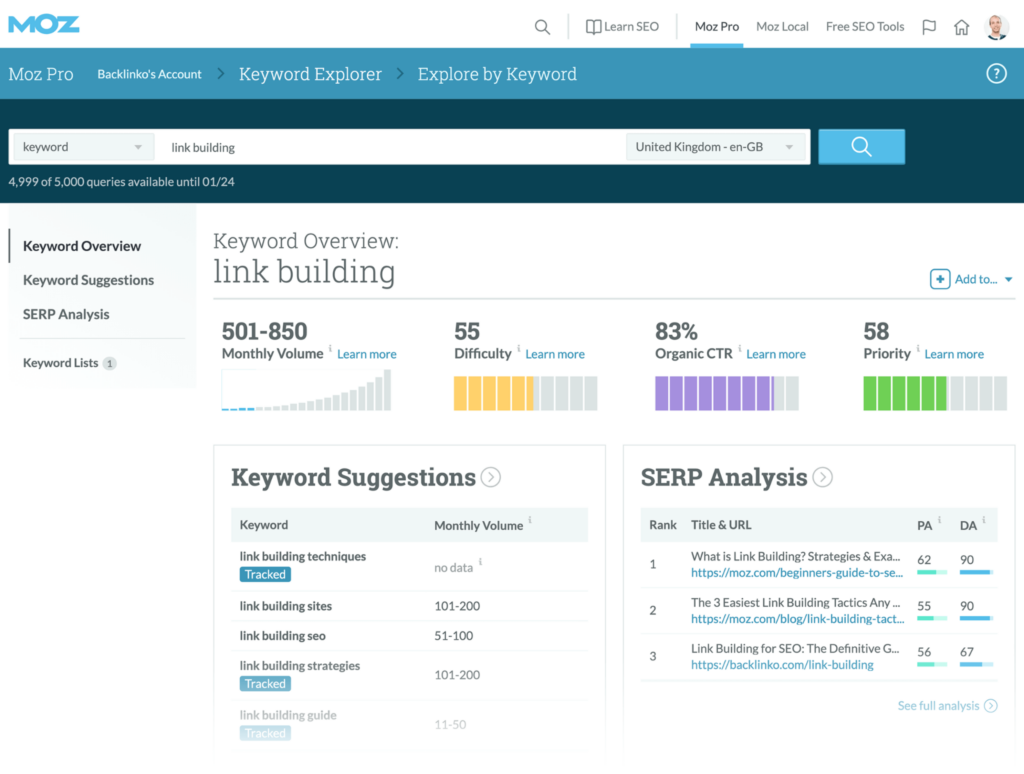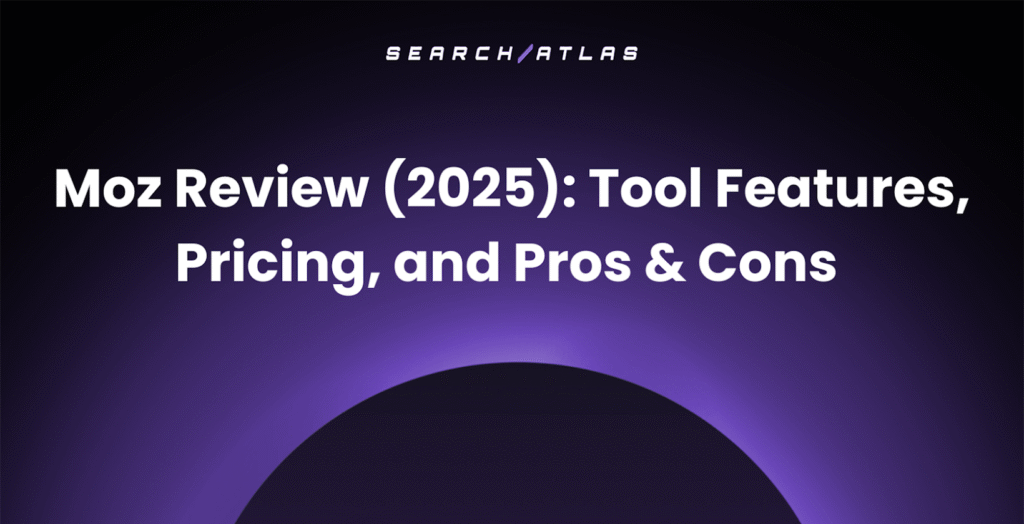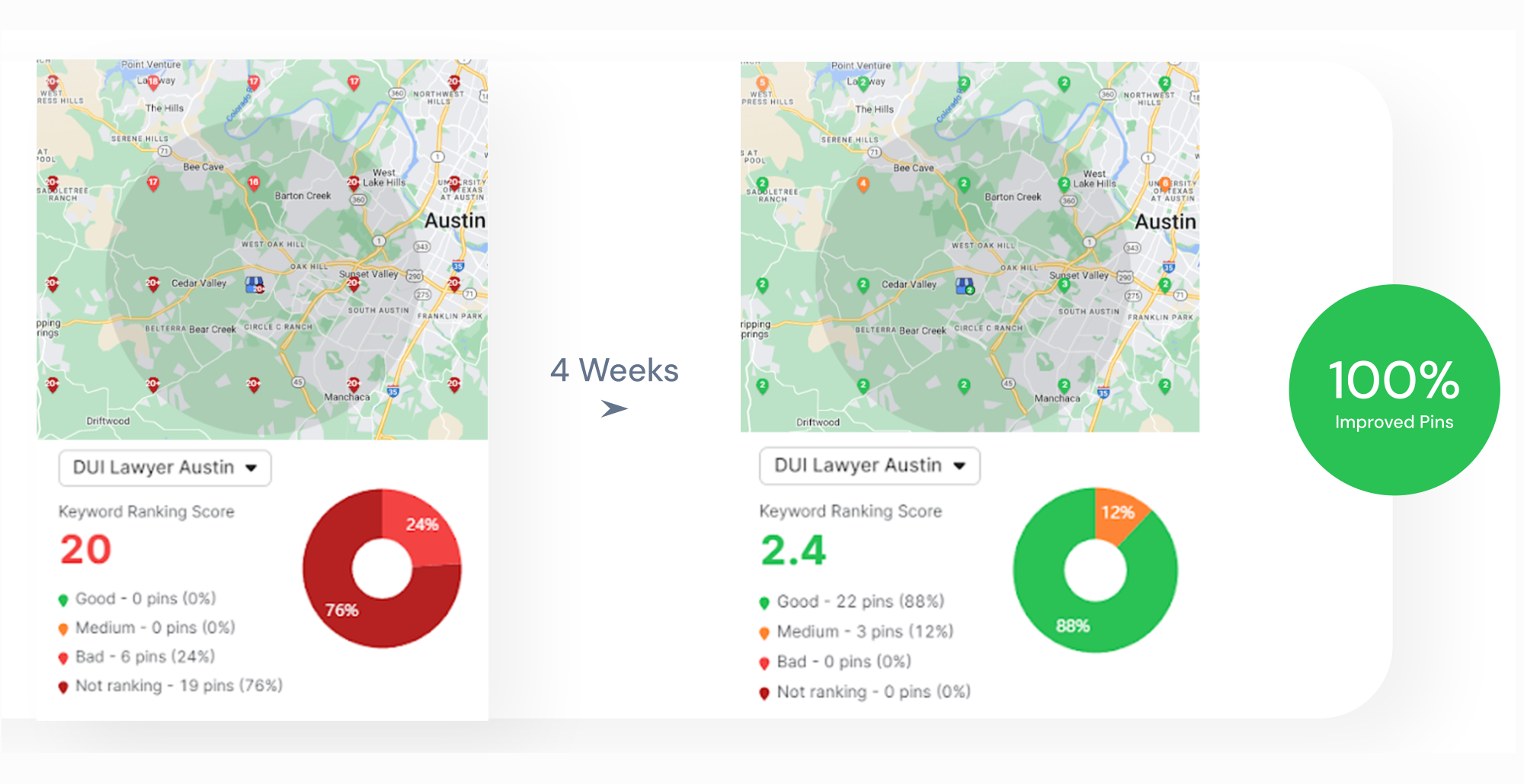In the world of SEO, the last thing you want is to target keywords that don’t drive any traffic to your site, especially when your competitors are already using the best tools to gain an advantage.
Without a reliable online keyword research tool to guide your SEO strategy, you’re essentially flying by the seat of your pants! 👖
Choosing the right tool now could make all the difference between a well-optimized campaign and one that fails to capture any meaningful search traffic.
Luckily for you, we’ve rounded up nine of the best keyword tools to help you find accurate data on search volume, competition levels, and trends. Outpace your competitors and unlock opportunities for growth with our handy guide. 📖
What Are Online Keyword Research Tools?
Online keyword research tools are software platforms designed to help users discover relevant and high-performing keywords for their SEO or PPC campaigns.
These tools provide data like search volume, competition levels, keyword difficulty, and trends. Having access to this data makes it a lot easier for businesses to optimize content for search engines.
By identifying the right keywords, companies of all sizes can effectively target their audience, improve search rankings, and drive more traffic to their websites. That’s why keyword research tools are pivotal for successful digital marketing strategies.

What You Need in an Online Keyword Research Tool
To stay ahead in the competitive world of SEO and online marketing, it’s important that you use a robust keyword research tool.
When you’re choosing a keyword research tool, here are a few key features you should consider:
- Comprehensive Keyword Data: Look for tools that offer detailed metrics, like search volume and keyword difficulty to guide your SEO efforts.
- Competitor Analysis: A tool with competitor keyword data can help you discover what your rivals are ranking for, giving you insights into untapped opportunities.
- Regional Keyword Insights: For local SEO campaigns, it’s crucial to have tools that provide location-specific keyword data to optimize for your target area.
- SERP Features Analysis: Knowing which search features (e.g., snippets, ads, maps) dominate the search results can help you strategize for the most visible position.
9 Best Online Keyword Research Tools
Explore millions of keywords and compare your rankings against multiple competitors by using these tools.
1. Search Atlas

SearchAtlas is an enterprise-level SEO platform designed to streamline keyword research for agencies and digital marketers. It offers access to an extensive database of over 5.2 billion keywords, providing in-depth metrics such as search volume insights, cost-per-click (CPC), keyword difficulty, and search intent.
The platform’s Keyword Magic Tool allows users to explore thousands of related keywords, variations, and questions.
This aids in the discovery of optimal ranking opportunities. Additionally, its Keyword Gap feature enables comparison of keyword rankings against competitors, helping identify strategic opportunities. SearchAtlas also supports regional keyword data analysis, beneficial for local SEO efforts.
Popular features
- Keyword Research Overview: Access metrics like search volume, CPC, keyword difficulty, and search intent for any search term.
- Keyword Magic Tool: Explore thousands of related keywords, variations, and questions to find optimal ranking opportunities.
- Keyword Gap Analysis: Compare keyword rankings against competitors to identify additional ranking opportunities.
- Keyword Lists: Manage the creation of multiple keyword lists, facilitating team collaboration.
- Regional Keyword Data: Deliver exact keyword metrics for specific geographic locations, aiding local SEO strategies.
- Content Planner: Generate a complete content plan for your SEO strategy and make use of automated keyword clustering and topic ideation.
- SEO Content Assistant: Maximize your SEO content production and learn the best terms to include in your content.
Limitations
- Some reviews mention that it can be difficult for new users, but there are resources and tutorials available to assist with onboarding.
- Search Atlas doesn’t have a free version of the keyword tool alone; it does offer a free trial for the all-in-one platform which includes all keyword research tools.
Pricing
| Starter plan | Growth plan | Pro plan | |
| Price | $99/month | $199/month | $399/month |
| Free OTTO SEO Activation | 1 | 1 | 4 |
| User Seats | 2 | 3 | 5 |
| GSC Site Projects | 5 | 15 | Unlimited |
| AI Quota | 100 | 250 | 99,999 |
Search Atlas reviews
- G2: 4.8/5 (91)
- Capterra: 4.9/5 (63)
2. WordTracker

WordTracker is a keyword research tool that offers insights into keyword performance across multiple search engines. It provides data on search volume, competition levels, and trends, aiding users in identifying profitable keywords for their SEO campaigns.
The tool also offers a feature to analyze competitors’ keywords, assisting in uncovering gaps in one’s own strategy. WordTracker supports both global and regional keyword research, catering to diverse SEO requirements. It even provides PPC insights using data from both Google and their own search technology.
Popular features
- Comprehensive Keyword Analysis: Collect data on search volume, competition levels, and trends across multiple search engines.
- Competitor Keyword Analysis: Identify competitors’ keywords to uncover gaps in one’s own SEO strategy.
- Global and Regional Research: Access both global and regional keyword research for diverse SEO needs.
- Keyword Suggestions: Get a wide range of keyword suggestions based on seed keywords.
Limitations
- Some users have mentioned that the user interface could be more intuitive.
- There have been observations about the pricing plans being less flexible.
Pricing
- Bronze: $17/month, 1,000 keyword results, 10 domain competitors, 1 ranking list, 1,000 ranking keyword results, 7 territories.
- Silver: $38/month, 1,000 keyword results, 20 domain competitors, 5 ranking lists, 5,000 ranking keyword results, 15 territories.
- Gold: $54/month, 2,000 keyword results, 50 domain competitors, 10 ranking lists, 10,000 ranking keyword results, 200 territories.
WordTracker reviews
- G2: 4.5/5 (11)
- Capterra: WordTracker currently has no ratings on Capterra.
3. KeywordTool.io

KeywordTool.io is a versatile keyword research tool that generates keyword suggestions from various search engines, including Google, YouTube, Bing, and Amazon. It specializes in providing long-tail keyword suggestions by analyzing autocomplete data. The tool can also be used to gain insights into user search behavior.
Users can find search terms related to their business domain then customize their web content accordingly. The tool supports multiple languages and regions, making it suitable for international SEO efforts.
Users can obtain hundreds of keyword suggestions per search engine. The free version can generate up to 750+ keywords from Google autocomplete in seconds
Popular features
- Multi-Platform Support: Generate keyword suggestions from Google, YouTube, Bing, and Amazon.
- Long-Tail Keyword Generation: Generate long-tail keyword suggestions by analyzing autocomplete data.
- Multi-Language and Region Support: Access keyword suggestions in various languages and regions for global SEO strategies.
- Extensive Keyword Suggestions: Get over 750 keyword suggestions per search engine, enhancing keyword research depth.
Limitations
- Some reviews suggest that the free version’s limited features may not suffice for comprehensive research needs.
- There have been mentions of the subscription costs being relatively high for advanced features.
Pricing
- Pro Basic: $69/month, search volume data, more keywords than free version, bulk search volume analysis, 1 user account.
- Pro Plus: $79/month, search volume data, cost-per-click date, competition data, more keywords than free version, bulk search volume analysis, 5 user accounts.
- Pro Business: $159/month, search volume data, cost-per-click date, competition data, more keywords than free version, bulk search volume analysis, 50 API request per day, 10 user accounts.
KeywordTool.io reviews
- G2: 4.5 /5(19)
- Capterra: 4.3/5 (36)
4. Ubersuggest

Ubersuggest is a user-friendly keyword research tool that provides keyword suggestions, search volume data, and competitive analysis. It offers insights into both organic and paid search strategies.
Their tool makes suggestions to help users with the game of SEO. How? By identifying high-performing keywords.
The tool also features a content ideas section, helping users find popular content related to their target keywords. Ubersuggest supports multiple languages, and it provides competitor insights. So, you can adopt their strategy and improve upon it to stand above the rest.
Popular features
- Keyword Suggestions: Generate keyword ideas based on seed keywords, aiding in discovering new opportunities.
- Search Volume Data: Access estimated search volume for keywords to assess potential traffic.
- Competitive Analysis: Gain insights into competitors’ top-performing keywords and strategies.
- Content Ideas: Get popular content suggestions related to target keywords for content strategy development.
Limitations
- Some reviews indicate that the keyword data may not be as extensive as premium tools.
- There have been mentions of occasional inaccuracies in search volume estimates.
Pricing
- Individual: $29/month, 150 reports per day, 1 project, 150 Chrome extension search limits, 125 tracked keywords per project, 1,000 pages crawled per site audit.
- Business: $49/month, 300 reports per day, 7 projects, 300 Chrome extension search limits, 150 tracked keywords per project, 5,000 pages crawled per site audit.
- Enterprise or Agency: $99/month, 900 reports per day, 15 project, 900 Chrome extension search limits, 300 tracked keywords per project, 10,000 pages crawled per site audit.
- Individual (Lifetime): $349, no monthly fees.
- Business (Lifetime): $599, no monthly fees.
- Enterprise or Agency (Lifetime): $1,199, no monthly fees.
Ubersuggest reviews
- G2: 4.2/5 (142)
- Capterra: 4.4/5 (92)
5. SpyFu

SpyFu is a competitive intelligence tool that specializes in uncovering competitors’ keyword strategies. It provides data on both organic and paid keywords, allowing users to analyze competitors’ top-performing keywords and ad copy.
The tool also offers a feature to track keyword rankings over time, aiding in monitoring SEO performance.
SpyFu supports historical data analysis. This allows users to understand long-term keyword trends and take the guesswork out of SEO.
It’s even useful for PPC campaigns because it helps identify the most profitable keywords by analyzing the historical performance of keywords and ad copy. Users can also track their own rankings to keep up with shifts in the competitive landscape. Their data brings visibility to help increase traffic and revenue.
Popular features
- Competitor Keyword Research: Uncover the keywords competitors rank for, both in paid and organic search.
- PPC Research: See competitor ad copy and discover what they are spending on paid search campaigns.
- Keyword Ranking History: Access historical keyword ranking data to spot long-term trends.
- Backlink Tracking: Identify backlinks that are helping competitors rank, giving users new link-building opportunities.
- SERP Analysis: Gain insights about competitors’ positioning on search engine results pages.
Limitations
- Some users have mentioned that the platform may not provide the most up-to-date keyword ranking data in real time.
- Reviews have suggested that the user interface can be overwhelming for new users.
Pricing
- Basic: $39/month, 10k row search results, 10k row data exports, 100 domain overview PDFs, 6 months historical data, 250 sales leads and domain contacts, 5k weekly tracked keyword rankings.
- Professional: $79/month, unlimited row search results, unlimited row data exports, unlimited domain overview PDFs, 10+ years historical data, 500 saes leads and domain contacts, 15k weekly tracked keyword rankings, API access.
SpyFu reviews
- G2: 4.6/5 (512)
- Capterra: 4.5 /5(144)
6. WordStream

WordStream is an all-in-one advertising platform for PPC management and keyword research. Its keyword research tool helps users discover relevant keywords for Google Ads and SEO, offering insights into search volume, competition, and cost-per-click.
WordStream’s focus is on simplifying keyword research for paid campaigns, making it an excellent option for small businesses or marketers looking to enhance their PPC efforts.
Additionally, it provides tools to optimize ad copy and campaign performance, making the process of managing Google Ads more streamlined.
Popular features
- PPC Keyword Research: Get keyword suggestions tailored to paid search campaigns, with data on search volume, competition, and CPC.
- Google Ads Performance Tracking: Monitor and optimize ad campaigns to improve ROI.
- Negative Keyword Tool: Help users identify and exclude irrelevant keywords to improve PPC performance.
- Keyword Niche Finder: Uncover niche keyword opportunities to enhance ad targeting and reach specific audiences.
- Free Keyword Tool: Get free keyword suggestions for SEO and paid campaigns, making it accessible for budget-conscious users.
Limitations
- Some users have noted that WordStream’s data can sometimes lag behind, resulting in less accurate or up-to-date insights.
- A few reviews have pointed out that WordStream is better for PPC rather than SEO keyword research.
Pricing
WordStream offers a free keyword tool. To access the advertising platform and other features, please reach out to their sales team for a quote.
WordStream reviews
- G2: WordStream currently has no ratings on G2.
- Capterra: WordStream currently has no ratings on Capterra.
7. Ahrefs

Ahrefs is a well-known SEO tool, offering powerful features for keyword research and backlink analysis.
Its Keywords Explorer feature provides detailed metrics, including search volume, keyword difficulty, and click-through rates (CTR). They have been crawling the web since 2010, which allows them to provide users with a comprehensive understanding of keyword potential.
Ahrefs is also known for its large keyword database, enabling users to discover new opportunities across search engines like Google, YouTube, and Amazon. It’s particularly popular for competitive analysis, too. This is because it offers insights into competitors’ top-performing keywords and backlinks.
Popular features
- Keywords Explorer: Get detailed metrics like search volume, keyword difficulty, and CTR for accurate keyword planning.
- Backlink Analysis: See detailed insights into backlink profiles, showing which links help competitors rank higher.
- Content Gap Tool: Identify keywords that competitors rank for but are missing from your content strategy.
- Rank Tracker: Monitor your website’s rankings and provides updates on changes over time.
- Site Explorer: Gain insights into organic traffic and top-performing pages of any website.
Limitations
- Some users report that Ahrefs can be expensive for small businesses or individual marketers.
- There have been comments about the platform’s steep learning curve for those unfamiliar with advanced SEO tools.
Pricing
- Lite: $129/month, 5 projects, 6 months of historical data, 750 tracked keywords, 100,000 crawl credits, 500 credits per user, 1 user included, add 2 more users at $40/mo each.
- Standard: $249/month, 20 projects, 2 years of historical data, 2,000 tracked keywords, 500,000 crawl credits, unlimited credits per user, 1 user included, add 5 more users at $60/mo each.
- Advanced: $449/month, 50 projects, 5 years of historical data, 5,000 tracked keywords, 1,500,000 crawl credits, Unlimited credits per user, 1 user included, add 10 more users at $80/mo each.
- Enterprise: $1,499/month, all advanced features plus API access, SSO & enterprise-grade security, access management & audit log, unlimited historical data.
Ahrefs reviews
- G2: 4.5/5(552)
- Capterra: 4.7/5(575)
8. Semrush

Semrush is a comprehensive SEO platform known for its extensive keyword research capabilities. Its Keyword Magic Tool helps users discover new keyword opportunities by offering search volume, competition, and trend data.
Semrush also allows users to track their rankings and monitor changes in their keyword performance over time. In addition to keyword research, Semrush includes features for backlink analysis, site auditing, and competitive analysis, making it a versatile tool for both SEO and PPC campaigns.
Popular features
- Keyword Magic Tool: Provides users with a wealth of keyword ideas, including search volume, competition, and trends.
- Competitor Keyword Research: Allows users to discover what keywords competitors are ranking for and how much they are spending on PPC.
- Position Tracking: Tracks keyword rankings and alerts users to changes in performance.
- Site Audit Tool: Evaluates your website’s SEO health and provides actionable recommendations.
Limitations
- Some reviews mention that the vast number of features can be overwhelming for new users.
- There are comments that Semrush’s keyword data might be less accurate for niche markets or regions outside of major countries.
Pricing
- Pro: $139.95/month, 5 projects, 500 keywords to track, 10,000 results per report.
- Guru: $249.95/month, 15 projects, 1,500 keywords to track, 30,000 results per report.
- Business: $499.95/month, 40 projects, 5,000 keywords to track, 50,000 results per report.
Semrush reviews
- G2: 4.5/5 (2,482)
- Capterra: 4.6/5 (2279)
9. Moz Pro

Moz Pro offers Keyword Explorer, a keyword research tool that helps users find high-potential keywords and assess their competitiveness.
With metrics like search volume, keyword intent and difficulty, and organic CTR, Moz offers users the information they need to prioritize their keyword strategy. Fast-track SEO success and start driving traffic that converts.
Moz is also known for its “Priority Score,” which ranks keywords based on a combination of search volume, difficulty, and potential impact.
It is a straightforward tool that suits both beginners and advanced marketers, helping them make informed decisions on which keywords to target.
Popular features
- Keyword Difficulty Score: Determine how hard it will be to rank for a particular keyword based on the current competition.
- Search Volume Data: Get search volume estimates to help users gauge the popularity of keywords.
- Organic CTR Data: Estimate how often searchers click on organic results for a given keyword.
- SERP Analysis: Gain insights into which websites are ranking for a keyword and their domain authority.
- Priority Score: Combine metrics like search volume, difficulty, and CTR to help users prioritize keywords effectively.
Limitations
- Some users note that Moz’s keyword database may not be as large as that of competitors like Ahrefs or Semrush.
- Reviews mention that the tool can occasionally produce slower load times compared to other SEO platforms.
Pricing
- Standard: $99/month, 1 user included, 3 tracked sites, 300 tracked keywords per mo, 400K pages crawled per mo.
- Medium: $179/month, 2 users included, 10 tracked sites, 1,500 tracked keywords per mo, 2m pages crawled per mo.
Moz reviews
- G2: 4.3/5 (569)
- Capterra: 4.5 (349)
Maximize Content Creation With the Best Online Keyword Research Tool
Any of the platforms listed above can provide you with valuable keywords for real results. If you’re eager to outpace the competition and secure content relevance, you can choose any one of them to gather useful insights.
But in order to truly refine your SEO strategy, you need a tool that covers all aspects of a content strategy.
From backlinks and content creation to technical SEO and localization, there are major benefits to choosing a comprehensive platform like Search Atlas.
Search Atlas offers every tool that you need to elevate your keyword research, analyze what’s working for your competitors, and fine-tune your strategy for an increase in organic traffic.
Boost your sales and let your SEO work smarter. 🤓
Why not automate your SEO and PPC keyword research? Start your FREE trial today! No commitment, cancel anytime!












